Despite a 19-30-7 record, the New Jersey Devils’ 2020-21 season was all about youth. In all, 18 players who played for the team were 23 years old or younger, including Jack Hughes and Nico Hischier, the cornerstones of the organization’s rebuild.
But the 2020-21 season wasn’t all about Hughes and Hischier. Several other young players made their marks on the Devils and have put themselves in a position to open the 2021-22 campaign on their NHL roster. Let’s take a look at the locks, who’s as good as a lock, and who’s on the cusp or needs to put in some work this offseason to win a spot on the big club come training camp in September.
The Locks
Jack Hughes
This one is as good as self-explanatory. If Hughes’ rookie season left you with any doubts about what his ceiling could be, he managed to erase those this season. He finished with 31 points in 56 games, a 45-point pace over 82 games. But that doesn’t tell the whole story, as he was arguably the Devils’ best player.
Hughes led the team in Corsi For percentage (CF%), expected goals percentage (xG%) and takeaways at five-on-five — his 49 takeaways were second-most in the league to only Leon Draisaitl. Hughes’ goals above replacement (GAR) of 9.5 and wins above replacement (WAR) of 1.7 also led the Devils. He’s on the cusp of being what made him the first overall pick at the 2019 Draft, and it’s a good bet that happens next season. It’s safe to say he won’t be going anywhere.
Nico Hischier
Hischier had an injury-riddled 2020-21, but that doesn’t change his standing in the organization. He finished the season with 11 points in only 21 games, though he had eight points over his final 13 contests — a 51-point pace over 82 games, which is about where he produced in his previous three NHL seasons.
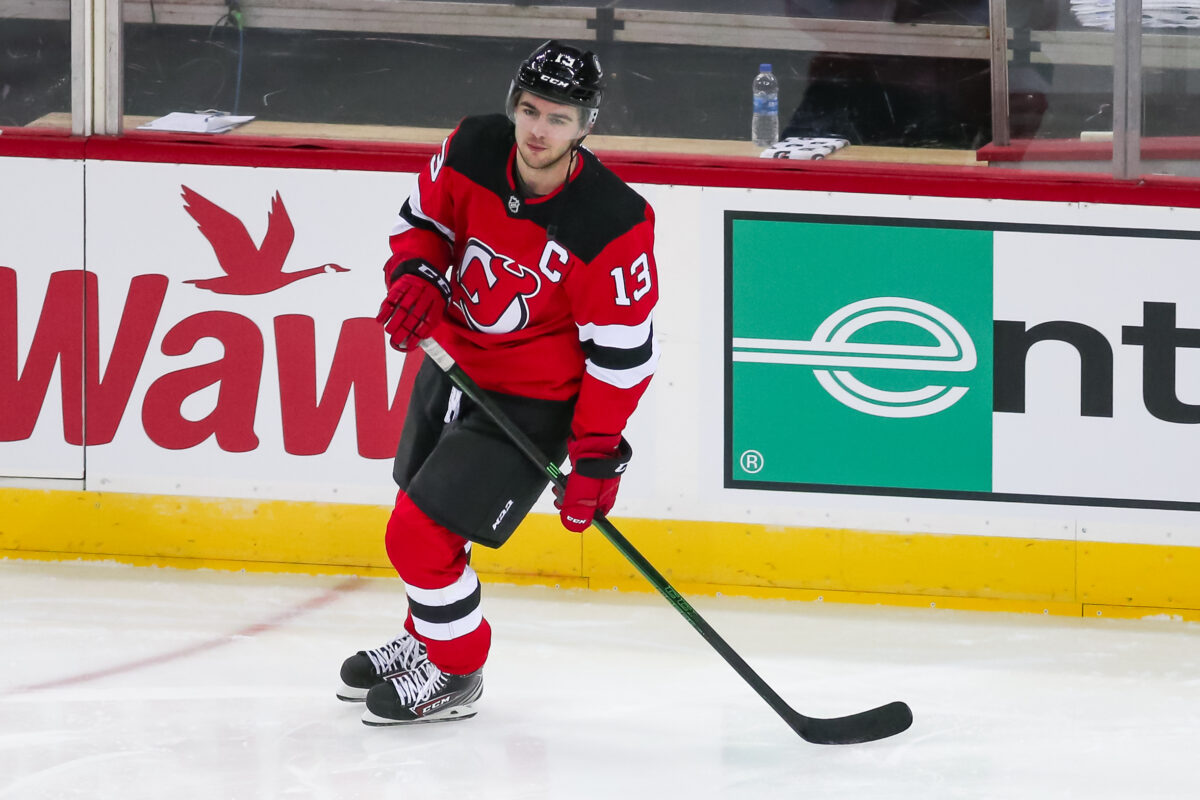
Hischier’s underlying numbers were well below what was expected of him; his CF% was 47 percent, while his xG% was 46.6 percent. But it was pretty much a lost season for him because of all the injuries. Still, he’s in it for the long haul. The Devils named him captain earlier in the season, so he isn’t going anywhere. He and Hughes are who they’ll build this team around not only for 2021-22 but for the next five-plus seasons.
Jesper Bratt
Bratt was two different players in 2019-20: the one before the Devils fired John Hynes and the one after they fired him. This season was about finding consistency, and he delivered. After missing the start of the season because of a contract holdout, Bratt was one of the Devils’ most consistent players, finishing with 30 points in 46 games — a 53-point pace over 82 games. That tracks close to his production levels after Hynes was no longer behind the bench last season.
Bratt’s underlying numbers were among the team’s best too. He finished with a CF% of 53.4 percent and xG% of 53.8 percent. His GAR of 7.3 and WAR of 1.3 were second on the team to Hughes, and his 1.88 points per 60 minutes tied him with Nick Merkley for third-best on the team (min. 100 minutes played). With that kind of season, it’s safe to say Bratt has proven he’s consistent enough to be a top-6 winger with the Devils for a long time.
Ty Smith
There’s been a lot of hype for Smith since the Devils selected him 17th overall at the 2018 Draft. He’s excelled at every level of hockey he’s played in, and his NHL career got off to a fine start in 2020-21. He finished with 23 points in 48 games, which comes out to a 39-point pace over 82 games. Not bad for a 20-year-old rookie defenseman playing top-4 minutes.
Related: Devils’ Tough 2020-21 Season Still Brings Optimism
Smith’s strength as a rookie was his offensive game, as his even-strength offense was worth a GAR of 3.4. With that said, he has work to do defensively — his even-strength defense was worth a GAR of -3.1, the worst mark on the team. I’d expect that to change as he gets older and adds more strength to his frame, but it’s clearly an area that needs improvement before he starts handling top-pair minutes. Still, it’d be a surprise if the Devils didn’t start building their blue line around him.
Pavel Zacha
If there’s a Devil who’d take home a surprise of the season award, it’d be Zacha. The Czech forward led the Devils in scoring with 35 points in 50 games, which comes out to a 57-point pace over 82 games. That’s easily the highest mark of his career, and it isn’t particularly close. His highest rate of production came in 2019-20 when he produced at a 40-point pace over 82 games, so perhaps this campaign was him continuing to build on a decent but not great season a year ago.
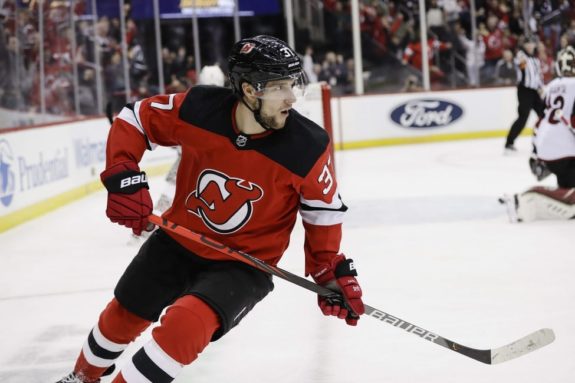
But a further look at some of Zacha’s underlying numbers raises some red flags. He finished the season with a CF% of 48.1 percent and xG% of 48.8 percent, meaning the Devils were out-attempted and out-chanced with him on the ice. His even-strength defense was worth a GAR of -1.8, so his defensive game is an issue. He also shot 16.5 percent and is a 10.9 percent shooter for his career. Granted, he averaged just over two shots on goal per game instead of the 1.4 he averaged in 2019-20. There’s no question he made strides and will be on the team next season, but can he repeat his production? Time will tell, but the Devils are sure hoping he can because they’ll need that scoring depth on the wing.
As Good As Locks
Yegor Sharangovich
Sharangovich’s season may have surprised some people. But for those who have been following him since he went on loan to Dinamo Minsk in the KHL in Sept. 2020, they’re probably not too shocked by his performance. While playing for Minsk, he totaled 17 goals and 25 points in 34 games, and that play translated to the NHL.
Sharangovich finished the NHL season with 16 goals and 30 points in 54 games — a 24-goal, 45-point pace over 82 games. He got off to a slow start with only 12 points in his first 33 games, but he went on a tear to close the season, finishing with 18 points in his final 21 contests. He finished with the seventh-best GAR and WAR on the team, so he seems like a good bet to be on the 2021-22 roster.
Janne Kuokkanen
Smith and Sharangovich may garner all the attention for their rookie performances, but Kuokkanen has an argument as the Devils’ best rookie too. Acquired from the Carolina Hurricanes at the 2020 Trade Deadline, Kuokkanen established himself as an NHL regular in what was his first full season in the league. He finished with 25 points in 50 games, which comes out to a 41-point pace over 82 games.
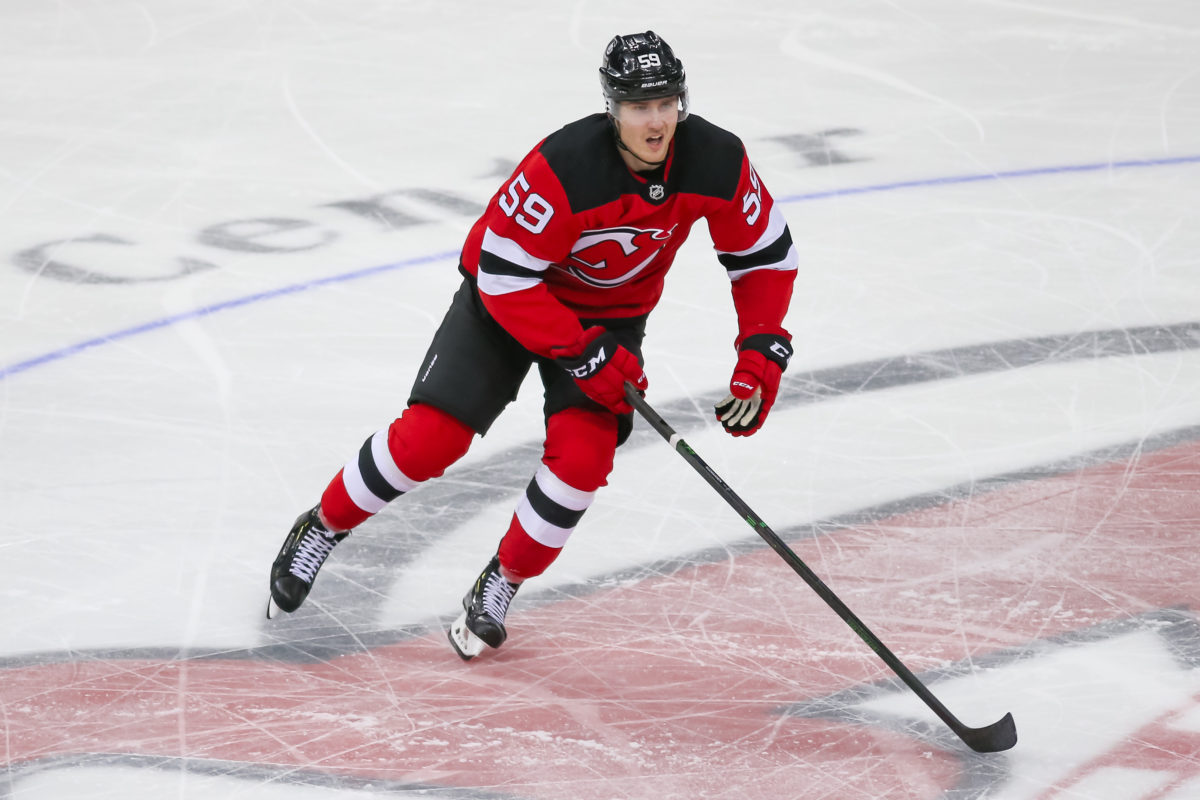
On the surface, that may not seem all that impressive, but Kuokkanen posted good underlying metrics. He had a CF% of 52 percent and was the team’s second-most efficient five-on-five scorer behind Travis Zajac, averaging 1.89 points per 60 minutes. Kuokkanen’s GAR and WAR were also the best among Devils’ rookies this season. His playmaking and passing abilities are his bread and butter, but he does need to shoot the puck more often. Averaging just 1.2 shots on goal per game won’t cut it moving forward, so it’s something to work on this offseason. Still, it seems like he’s in a good spot to stick around, especially since he gelled on a line with Hughes and Sharangovich over the final month of play.
Michael McLeod
If there’s a Devils’ player deserving of a most improved award, McLeod would be it. He had two previous stints in the NHL and combined for five points in 33 games from 2018 until the COVID pause last March. Whatever he did in the 10 months between then and the start of this season paid off because he looked like he belonged in the NHL.
McLeod finished the season with nine goals and 15 points in 52 games. He mostly played as a fourth-line center but handled that role well. He also became one of the team’s top penalty killers as the season progressed. His underlying metrics don’t pop off the page, but he gave the Devils production they haven’t had from their fourth-line center since Brian Boyle in 2017-18 (nine goals in 52 games equates to 14 in an 82-game season). As long as he doesn’t get selected by the Seattle Kraken at the expansion draft in July, he should be on the team in September.
Jonas Siegenthaler
Though the Devils were sellers at the trade deadline, they still acquired Siegenthaler in exchange for a third-round pick at the 2021 Draft. He had only played in seven games with the Washington Capitals this season, so they moved him to give him a change of scenery since their blue line had plenty of depth.
Unfortunately, Siegenthaler only played eight games for the Devils due to a bout with COVID. But in those eight games, he did show why the Devils decided to take a chance on him. Siegenthaler had a CF% of 51.1 percent and xG% of 54.6 percent and was one of the team’s best shot suppressors, allowing 1.85 expected goals per 60 minutes. He might not have the offensive upside to be more than a third-pair defenseman, but he seems capable of filling that role well while killing penalties too.
Nathan Bastian
Bastian is in a similar boat to McLeod, though this season was his first real taste of the NHL. While he missed time due to a sprained MCL, he finished with 10 points in 41 games. Like McLeod, Bastian mostly played a fourth-line role and handled the minutes well. He also became one of the team’s top penalty killers as the season went along.
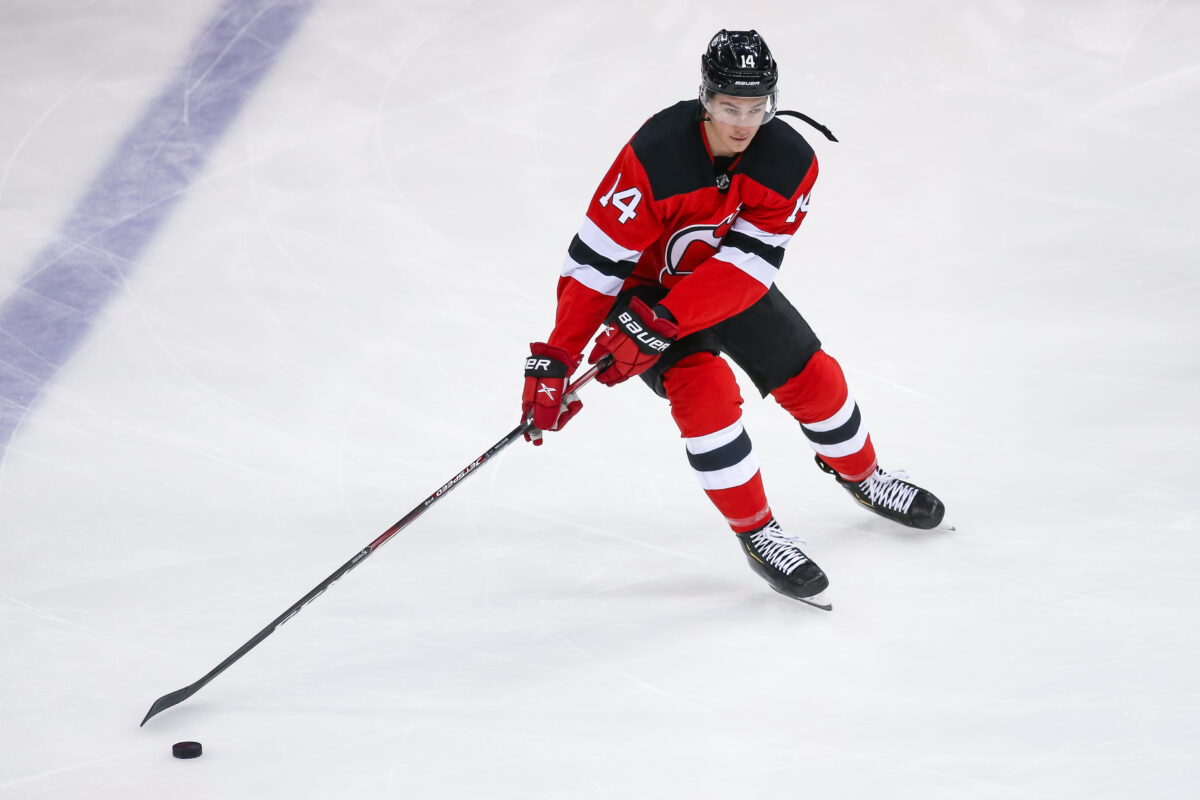
Where Bastian may differ from McLeod is his five-on-five numbers were better. He finished with a CF% of 49.9 percent and xG% of 50.7 percent, though he did play in 11 fewer games than McLeod. His ceiling isn’t much higher than a fourth-liner, so my guess is the Devils will expose him at the expansion draft. At the same time, it’d be a surprise if the Kraken selected him, so he should be back to give the Devils some depth in their bottom-6 for next season.
On the Cusp
Mikhail Maltsev
Maltsev missed some time with injuries and was a healthy scratch on a few occasions. But in the games he did play, he left a lasting impression. He finished the season with six goals and nine points in 33 games, but his underlying metrics were encouraging. His CF% was just above 52 percent, while his GAR of 1.6 was top 10 on the Devils.
Maltsev is certainly not shy about shooting the puck, as he fired 50 shots on goal at five-on-five. The catch is not all of them were quality looks. His individual xG at that game state was 3.85, and he had just 16 high-danger chances, so he needs to shoot more from high-danger areas. If he can do that, he has ideal bottom-six forward written all over him. That could prove valuable if the Devils lose McLeod at the expansion draft.
Nick Merkley
Merkley had an odd season of sorts. He finished with 10 points in 27 games, which is a 30-point pace over 82 games. But he had trouble staying in the lineup consistently, and when he did play, head coach Lindy Ruff didn’t seem to always trust playing him in meaningful minutes.
Related: Devils Exit Interviews: Day 1 Recap
And there’s a reason why Ruff used Merkley the way he did. He had an xG% below 45 percent, meaning the Devils gave up quite a few quality shots when he was on the ice. Merkley needs to improve defensively, and adding some speed to his game would probably serve him well. With that said, he was the Devils’ third-most efficient five-on-five scorer, so he did produce. If he can improve what he needs to this offseason, he’ll increase his chances of being a regular next season.
Nolan Foote
Acquired in the trade that sent Blake Coleman to the Tampa Bay Lightning at the 2020 Trade Deadline, Foote has quickly emerged as one of the Devils’ top prospects. He was one of Binghamton’s best players in the AHL and earned himself a call-up over the last few weeks of the season to see where his game is. He played in six contests and finished with only a goal and an assist, but he showed some promise.
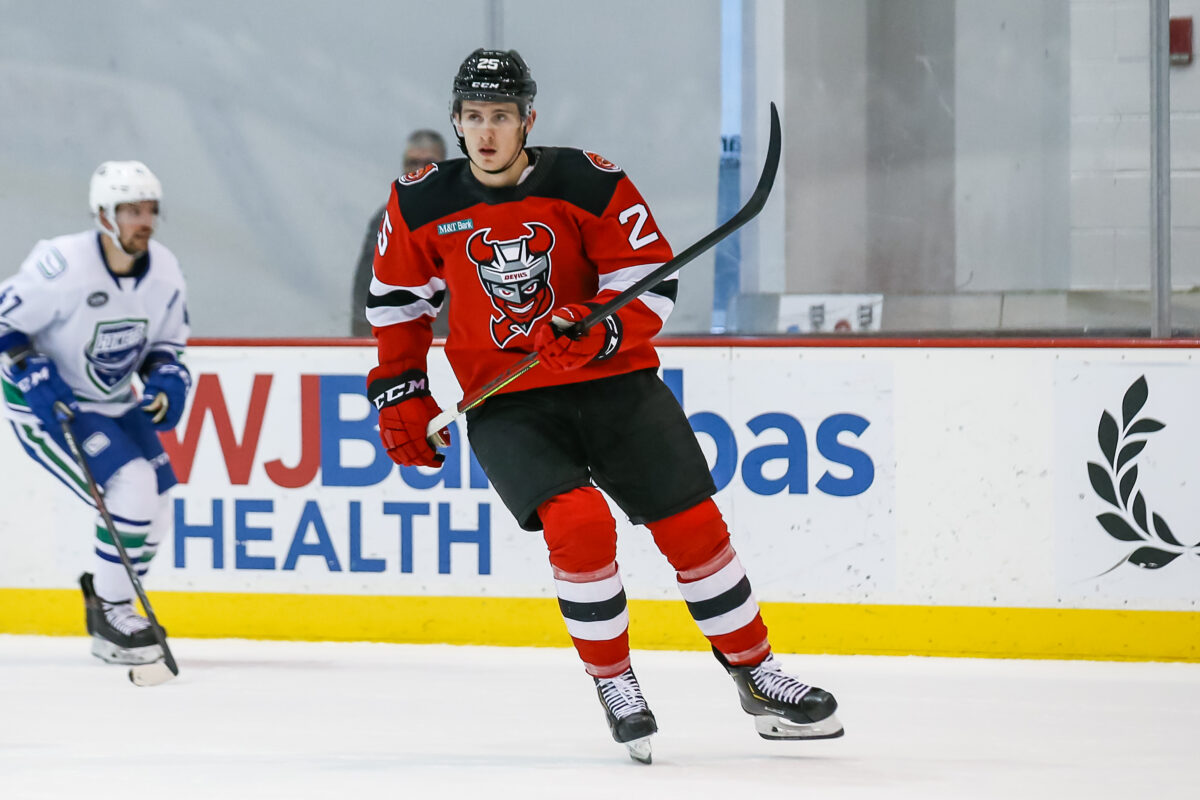
Foote is a rare combination of size and skill and has a howitzer of a shot. He needs to improve his skating, but the tools are there. His first NHL goal was a memorable one, and he has the goal-scoring potential on the wing the Devils need at the NHL level. He has 16 points in 22 AHL games with two contests to go. He might not begin next season in the NHL, but he’s not that far off either.
Tyce Thompson
Thompson has been on quite the upward trajectory since the Devils drafted him in the fourth round of the 2019 Draft. He had a breakout D+1 season with Providence College in 2019-20, totaling 44 points in 34 games. His production slipped a bit this season, but he still averaged a point-per-game on a weaker than usual Providence squad.
After completing his NCAA season, Thompson signed his entry-level deal and joined the Devils for the remainder of their campaign. He only played in seven games, but what he showed was encouraging. He had a CF% of 54.6 percent and xG% of 61 percent. It’s a small sample size, of course, but there’s an NHL player brewing with him too. He’s only 180 pounds, so he needs to add some much-needed strength to his frame. It’s unlikely he begins next season in the NHL, but he doesn’t appear too far away from being ready either.
Work to Do
Jesper Boqvist
Progress isn’t always a straight line, and Boqvist is a prime example of this. After finishing with 35 points in 51 games during the 2018-19 SHL season, he’s struggled in his time with the Devils. He finished with seven points in 28 games and had a GAR and WAR below replacement level this season.
Related: Devils Exit Interviews: Day 2 Recap
With that said, Boqvist looked more comfortable at center over the final month or so of play. He’s a high-end skater and possesses some skill, but the key with him will be gaining the confidence to use that skill to generate more offense while being a bit more aggressive. When I say aggressive, that doesn’t mean being physically imposing, but he needs to be more assertive shooting the puck and facilitating play. If he can do that, there’s a middle-six forward in him. And remember, he’s only 22 years old and has played just 63 NHL games. There’s still time for him to figure it out.
Kevin Bahl
Bahl was the centerpiece of the trade that sent Taylor Hall to the Arizona Coyotes in Dec. 2019. He made his NHL debut at the end of this season and tallied his first career point in his second career game. While he had some good moments in his short NHL stay, his play left a lot to be desired.
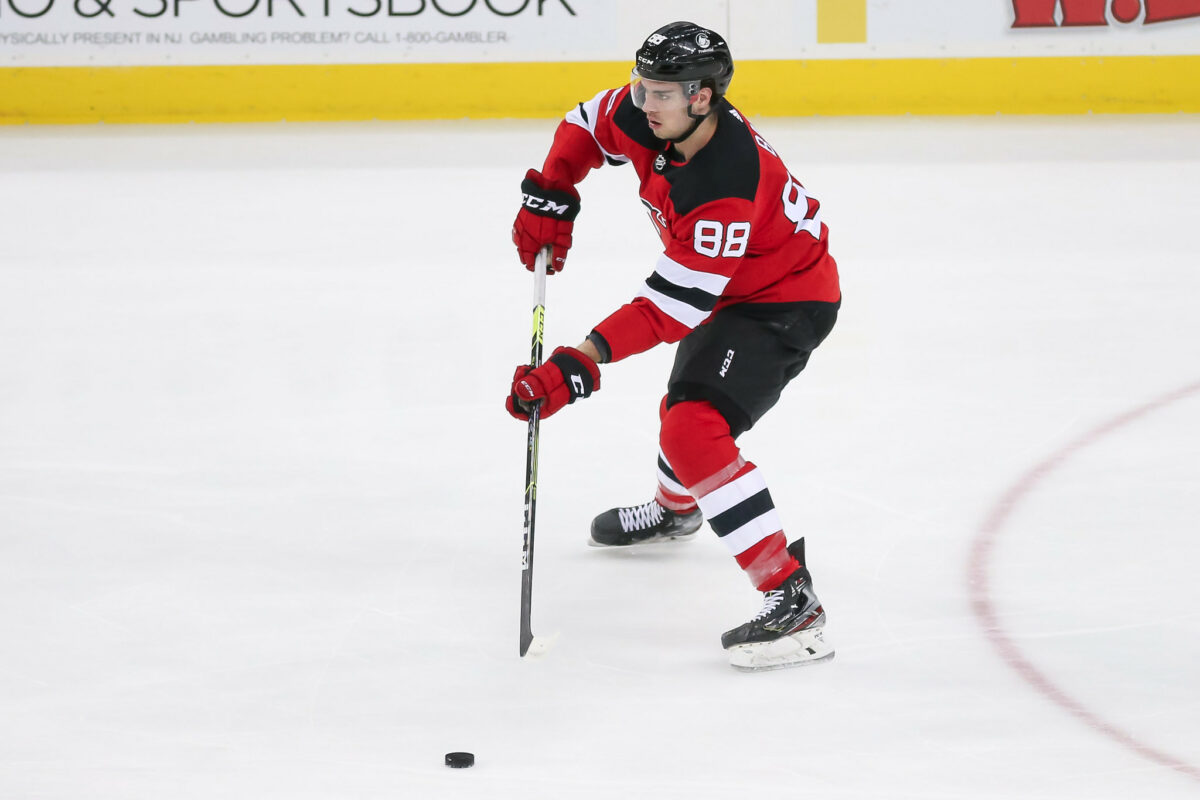
In his seven games, Bahl had a CF% of 41.2 percent and xG% of 34 percent. It’s hard to miss him at 6-foot-6, 230 pounds, but he needs to round out quite a few parts of his game. Bahl skates quite well for someone his size but must improve in transition, whether it’s skating the puck out of the defensive zone himself or making clean breakout passes. Time will tell what kind of role he has in the NHL, but he still has a ways to go before becoming a regular. An extended run in the AHL to begin next season would be best for his development.
Marián Studenič
Studenič, a 2017 fifth-round pick, got his first taste of the NHL this season. He played in eight games and had some good moments in limited minutes, including a pretty first-career goal. His upside is probably a fourth-liner at best, but he’s made progress since the Devils drafted him. It’d be a surprise if he made the NHL roster out of camp, but he should have an important role for the Utica Comets, the Devils’ new AHL affiliate. If he gets off to a strong start there, he could find his way back to the NHL.
Youth Movement in Full Force
General manager Tom Fitzgerald’s vision for this team is quite apparent; he wants them to be young, fast and skilled. They gave an overwhelming amount of their young players and prospects extended looks in the NHL, which should help their development moving forward. Not every player will hit, but they have enough talent in their system where they will hit on meaningful contributors. And with the likes of Kuokkanen, Sharangovich and Smith having successful rookie seasons, that should continue in 2021-22 as the Devils inject more youth into their roster.
* * *
Advanced stats from Natural Stat Trick, Evolving-Hockey